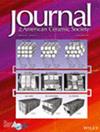Ca3Sc2Si3O12:Ce3+, Mn2+ 磷陶瓷:有望用于全彩激光照明的色彩转换器
IF 3.5
3区 材料科学
Q1 MATERIALS SCIENCE, CERAMICS
引用次数: 0
摘要
在高亮度激光照明中,荧光粉陶瓷被认为是前景广阔的色彩转换器。然而,目前的激光照明在使用单一结构的荧光粉陶瓷时,通常存在显色指数较低(Ra ∼ 70)的问题,这是由于发光光谱中的青绿色和红色成分存在缺陷。本研究首次采用固态反应方法制备了一系列 Ca3Sc2Si3O12:Ce3+, Mn2+ (CSS:Ce3+, Mn2+)荧光粉陶瓷。基于从 Ce3+ 到 Mn2+ 的高效能量转移(能量转移效率为 ∼33.3%),这些陶瓷在 505、580 和 680 纳米波长处显示出三个不同的发射峰,分别覆盖青绿光、黄光和深红光区域。此外,这些陶瓷还具有出色的热稳定性,热淬火温度(T0.5)超过 160°C。最后,通过将 CSS:Ce3+、Mn2+ 陶瓷与蓝色激光二极管相结合,构建了一种激光光源。通过优化 Mn2+ 浓度,实现了从青绿色到白色的可调颜色,白光的 Ra 值和光效分别为 86 和 65 lm/W。这些结果表明,CSS:Ce3+, Mn2+荧光粉陶瓷是一种用于全彩激光照明的优秀色彩转换器。本文章由计算机程序翻译,如有差异,请以英文原文为准。
Ca3Sc2Si3O12:Ce3+, Mn2+ phosphor ceramic: A promising color converter for full‐color laser lighting
Phosphor ceramics are considered to be promising color converters for high‐brightness laser lighting. However, current laser lighting usually suffers from a poor color rendering index (Ra ∼70) when using a single‐structured phosphor ceramic, due to the deficiencies in the cyan‐green and red components of the luminescence spectra. In this study, a series of Ca3 Sc2 Si3 O12 :Ce3+ , Mn2+ (CSS:Ce3+ , Mn2+ ) phosphor ceramics were prepared for the first time using a solid‐state reaction method. Based on the efficient energy transfer from Ce3+ to Mn2+ (with an energy transfer efficiency of ∼33.3%), these ceramics exhibit three distinct emission peaks appearing at 505, 580, and 680 nm, covering the cyan‐green, yellow, and deep red‐light regions, respectively. Additionally, the ceramics display excellent thermal stability, with a thermal quenching temperature (T 0.5 ) exceeding 160°C. Finally, a laser lighting source was constructed by combining the CSS:Ce3+ , Mn2+ ceramic with a blue laser diode. By optimizing the Mn2+ concentration, a tunable color from cyan‐green to white was achieved, and the resulting Ra and luminous efficacy of the white light were 86 and 65 lm/W, respectively. These results demonstrate that the CSS:Ce3+ , Mn2+ phosphor ceramic is an excellent color converter for full‐color laser lighting.
求助全文
通过发布文献求助,成功后即可免费获取论文全文。
去求助
来源期刊

Journal of the American Ceramic Society
工程技术-材料科学:硅酸盐
CiteScore
7.50
自引率
7.70%
发文量
590
审稿时长
2.1 months
期刊介绍:
The Journal of the American Ceramic Society contains records of original research that provide insight into or describe the science of ceramic and glass materials and composites based on ceramics and glasses. These papers include reports on discovery, characterization, and analysis of new inorganic, non-metallic materials; synthesis methods; phase relationships; processing approaches; microstructure-property relationships; and functionalities. Of great interest are works that support understanding founded on fundamental principles using experimental, theoretical, or computational methods or combinations of those approaches. All the published papers must be of enduring value and relevant to the science of ceramics and glasses or composites based on those materials.
Papers on fundamental ceramic and glass science are welcome including those in the following areas:
Enabling materials for grand challenges[...]
Materials design, selection, synthesis and processing methods[...]
Characterization of compositions, structures, defects, and properties along with new methods [...]
Mechanisms, Theory, Modeling, and Simulation[...]
JACerS accepts submissions of full-length Articles reporting original research, in-depth Feature Articles, Reviews of the state-of-the-art with compelling analysis, and Rapid Communications which are short papers with sufficient novelty or impact to justify swift publication.
 求助内容:
求助内容: 应助结果提醒方式:
应助结果提醒方式:


